Once upon a time, two wizards decided to remake the face of computer gaming with the help of a new form of magic known as CD-ROM. They labored for years on their task, while the people waited anxiously, pouncing upon the merest hint the wizards let drop of what the final product would look like.
At long last — well after the two wizards themselves had hoped — the day of revelation came. Everyone, including both the everyday people and the enlightened scribes who kept them informed on the latest games, rushed to play this one, which they had been promised would be the best one ever. And at first, all went as the wizards had confidently expected. The scribes wrote rapturously about the game, and hordes of people bought it, making the wizards very rich.
But then one day a middle-aged woman, taking a break from reckoning household accounts by playing the wizards’ game, said to her husband, “You know, honey, this game is really kind of slow and boring.” And in time, a murmur of discontent spread through many ranks of the people, gaining strength all the while. The cry was amplified by a disheveled young man with a demon of some sort on his tee-shirt and a fevered look in his eyes: “That’s what I’ve been saying all along! The wizards’ game sucks! Play this one instead!” And he hunched back down over his computer to continue playing his very different sort of game, muttering something about “gibs” and “frags” as he did so.
The two wizards were disturbed by this growing discontent, but resolved to win the people over with a new game that would be just like their old one, except even more beautiful. They worked on it too for years to make it as amazing as possible. Yet when they offered it to the people, exponentially fewer of them bought it than had bought their first game, and their critics grew still louder and more strident. They tried yet one more new game of the same type, yet more beautiful, but by now the people had lost interest entirely; few could even be bothered to criticize it. The wizards started bickering with each other, each blaming the other for their failures.
One of the wizards, convinced he could do better by himself, went away to make still more games of the same type, but the people remained stubbornly uninterested; he finally gave up and found another occupation. From time to time, he tries again to see if the people want another game like the one they seemed to love so much on that one occasion long ago, but he is invariably disappointed.
The other wizard — perhaps the wiser of the two — said, “If you can’t beat ’em, join ’em.” He joined the guild that included the violent adolescent with the demon on his shirt, and enjoyed a return to fortune if not fame.
Such is the story of Trilobyte Games in a nutshell. Today, we remember 1993 as the year that Cyan Productions and id Software came to the fore with Myst and Doom, those two radically different would-be blueprints for gaming’s future. But we tend to forget that the most hyped company and game of the year were in fact neither of those pairings: they were rather Trilobyte and their game The 7th Guest. Echoing the conventional wisdom of the time, Bill Gates called The 7th Guest “the future of multimedia,” and some even compared Graeme Devine and Rob Landeros, the two “wizards” who had founded Trilobyte together, to John Lennon and Paul McCartney. Sadly for the wizards, however, The 7th Guest had none of the timeless qualities of the Beatles’ music; it was as of its own time as hula hoops, love beads, or polyester leisure suits were of theirs.
Unlike their alter egos in the Beatles, Graeme Devine and Rob Landeros grew up in vastly different environments, separated not only by an ocean but by the equally enormous gulf of seventeen years.
Born in Glasgow, Scotland, in 1966, Devine was one of the army of teenage bedroom coders who built the British games industry from behind the keyboards of their Sinclair Spectrums. His first published work was actually a programming utility rather than a game, released as part of a more complete Speccy programmer’s toolkit by a company known as Softek in the spring of 1983. But it was followed by his shoot-em-up Firebirds just a few months later. That game’s smooth scrolling and slick presentation won him a reputation. Thus one day the following year the phone rang at his family’s home; a representative from Atari was on the line, asking if he would be free to port their standup-arcade and console hit Pole Position to the Spectrum.
Over the next several years, Devine continued to port games from American publishers to the Europe-centric Spectrum, while also making more original games of his own: Xcel (1985), Attack of the Killer Tomatoes (1986), Metropolis (1987). His originals tended to be a bit half-baked once you really dove in, but their technical innovations were usually enough to sustain them, considering that most of them only cost a few quid. Metropolis, the first game Devine programmed for MS-DOS machines, provides a prime example of both his technical flair and complete lack of detail orientation. A sort of interactive murder mystery taking place in a city of robots, sharing only a certain visual sensibility with the Fritz Lang film classic of the same name, it includes almost-decipherable “voice acting” for its characters, implemented without the luxury of a sound card, being played entirely through the early IBM PC beeper. The game itself, on the other hand, is literally unfinished; it breaks halfway through its advertised ten cases. Perhaps Devine decided that, given that he included no system for saving his rather time-consuming game, no one would ever get that far anyway.
Metropolis was published through the British budget label Mastertronic, whose founder Martin Alper was a force of nature, famous as a cultivator of erratic young talent like Devine. Alper sold Mastertronic to Richard Branson’s Virgin Media empire just after Metropolis was released, and soon after that absconded to Southern California to oversee the newly formed American branch of Virgin Games. On a routine visit back to the Virgin mother ship in London in 1988, he dropped in on Devine, only to find him mired in a dark depression; it seemed his first serious girlfriend had just left him. “England obviously isn’t treating you well,” said Alper. “Why don’t you come with me to California?” Just like that, the 22-year-old Devine became the head of Virgin Games’s American research and development. It was in that role that he met Rob Landeros the following year.
Landeros’s origin story was about as different from Devine’s as could be imagined. Born in 1949 in Redlands, California, he had lived the life of an itinerant bohemian artist. After drifting through art school, he spent much of the 1970s in hippie communes, earning his keep by drawing underground comic books and engraving tourist trinkets. By the early 1980s, he had gotten married and settled down somewhat, and found himself fascinated by the burgeoning potential of the personal computer. He bought himself a Commodore 64, learned how to program it in BASIC, and even contributed a simple card game to the magazine Compute!’s Gazette in the form of a type-in listing.
But he remained a computer hobbyist only until the day in early 1986 that an artist friend of his by the name of Jim Sachs showed him his new Commodore Amiga. Immediately struck by the artistic possibilities inherent in the world’s first true multimedia personal computer, Landeros worked under Sachs to help illustrate Defender of the Crown, the first Amiga game from a new company called Cinemaware. After that project, Sachs elected not to stay on with Cinemaware, but instead recommended Landeros for the role of the company’s art director. Landeros filled that post for the next few years, illustrating more high-concept “interactive movies” which could hardly have been more different on the surface from Devine’s quick-and-dirty budget games — but which nevertheless tended to evince some of the same problems when it came to the question of their actual gameplay.
Whatever its flaws in that department, Martin Alper over at Virgin was convinced that the Cinemaware catalog was an early proof of concept for gaming’s future. As Cinemaware founder Bob Jacob and many others inside and outside his company well recognized, their efforts were hobbled by the need to rely on cramped, slow floppy disks to store all of their audiovisual assets and stream them into memory during play. But with CD-ROM on the horizon for MS-DOS computers, along with new graphics and sound cards that would make the platform even more audiovisually capable than the Amiga, that could soon be a restriction of the past. Alper asked Devine to interview Landeros for the role of Virgin’s art director.
Landeros was feeling “underappreciated and underpaid” at Cinemaware, as he puts it, so he was very receptive to such an offer. When he called Devine back after hearing the message the latter had left on his answering machine, he found the younger man in an ebullient mood. He had just gotten engaged to be married, Devine explained, to a real California girl — surely every cloistered British programmer’s wildest fantasy. Charmed by the lad’s energy and enthusiasm, Landeros let himself be talked into a job. And indeed, Devine and Landeros quickly found that they got on like a house on fire.
Tall and skinny and bespectacled, with unkempt long hair flying everywhere, Devine alternated the euphoria with which he had first greeted Landeros with bouts of depression such as the one Martin Alper had once found him mired in. Landeros was calmer, more grounded, as befit his age, but still had a subversive edge of his own. When you first met him, he had almost a patrician air — but when he turned around for the first time, you noticed a small ponytail snaking down his back. While Devine was, like so many hackers, used to coding for days or weeks on end, sometimes to the detriment of his health and psychological well-being, Landeros needed a very good reason indeed to give up his weekend motorcycle tours. Devine was hugely impressed by Landeros’s tales of his free-spirited life, as he was by the piles of self-inked comic books lying about his home; Landeros was repeatedly amazed simply at the things Devine could make computers do. The two men complemented each other — perhaps were even personally good for one another in some way that transcends job and career.
Their work at Virgin, however, wasn’t always the most exciting. The CD-ROM revolution proved late in arriving; in the meantime, the business of making games continued pretty much as usual. In between his other duties, Devine made Spot, an abstract strategy game which betrayed a large debt to the ancient Japanese board game of Go whilst also serving as an advertisement for the soft drink 7 Up; if not quite a classic, it did show more focus than his earlier efforts. Meanwhile Landeros did the art for a very Cinemaware-like cross-genre concoction called Spirit of Excalibur. In his spare time, he also helped his friend and fellow Cinemaware alumnus Peter Oliphant with a unique word-puzzle/game-show hybrid called Lexi-Cross. (Rejected by Alper because “game shows need a license in order to sell,” it was finally accepted by Interplay after that company’s head Brian Fargo brought a copy home to his wife and she couldn’t stop playing it. Nonetheless, it sold hardly at all, just as Alper had predicted.)
Devine and Landeros were itching to work with CD-ROM, but everywhere they went they were told that the market just wasn’t there yet. As they saw it, no one was buying CD-ROM drives because no one was making compelling enough software products for the new medium. It was a self-fulfilling prophecy, a marketplace Gordian knot which someone had to break. Accordingly, they decided to put together their own proposal for a showpiece CD-ROM game. Both were entranced by Twin Peaks, the darkly quirky murder-mystery television series by David Lynch, which had premiered in the spring of 1990 and promptly become an unlikely mass-media sensation. Sitting in the airport together one day, they overheard the people around them debating the question of the year: who killed Laura Palmer?
Imagine a game that can fascinate in the same way, mused Devine. And so they started to brainstorm. They pictured a game, perhaps a bit like the board game Clue — tellingly, the details of the gameplay were vague in their minds right from the start — that might make use of a Twin Peaks license if such a thing was possible, but would go for that sort of vibe regardless. Most importantly, it would pull out all the stops to show what CD-ROM — and only CD-ROM — could do; there would be no floppy version. Indeed, the project would be thoroughly uncompromising in all of its hardware requirements, freeing it from the draconian restrictions that came with catering to the lowest common denominator. It would require one of a new generation of so-called “Super” VGA graphics cards, which would let it push past the grainy resolution of 320 X 200, still the almost universal standard in games, to a much sharper 640 X 480.
To keep the development complications from spiraling completely out of control, it could take place in a haunted house that had a group of people trapped inside, being killed one by one. Sure, Agatha Christie had done it before, but this would be different. Creepier. Darker. A ghost story as well as a mystery, all served up with a strong twist of David Lynch. “Who killed Laura Palmer? Who killed Laura Palmer? We wanted to create that sort of intrigue,” remembers Landeros.
When they broached the possibility of a Twin Peaks game with Alper, he was definitive on one point: there wasn’t enough room in his budget to acquire a license to one of the hottest media properties in the country. They should therefore focus their thinking on a Twin Peaks-like game, not the real thing. Otherwise, he was noncommittal. “Give me a detailed written proposal, and we’ll see,” he said.
At this point in our story, it would behoove us to know something more of Martin Alper the man, a towering figure whose shadow loomed large over all of Virgin Games. A painter and sculptor of some talent during his free time, Alper was also an insatiable culture vulture, reading very nearly a novel per day and seeing several films per week. His prodigious consumption left no space for games. “I’ve never played any game,” he liked to boast. “What interests me is the cultural progress that games can generate. I’m looking to make a difference in society.” He liked to think of himself as a 1990s incarnation of Orson Welles, nudging his own group of Mercury Players into whole new fields of creative expression. When Devine and Landeros’s detailed proposal landed on his desk in November of 1990, full of ambition to harness the current zeitgeist in the service of a new medium, it hit him right where he lived. Even the proposed budget of $300,000 — two to three times that of the typical Virgin game — put him off not at all.
So, he invited Devine and Landeros to a lunch which has since gone down in gaming lore. After the niceties had been dispensed with, he told the two bluntly that they had “no future at Virgin Games.” He enjoyed their shock for a while — a certain flair for drama was also among his character traits — then elaborated. “Your idea is too big to be developed here. If you stayed here, you’d quickly overrun our offices. I can’t afford to let you do that. Other games have to be made here as well.”
“What do you suggest?” ventured Devine.
And so Alper laid out his grand plan. They should start their own studio, which Virgin Games would finance. They could work where they liked and hire whomever they liked, as long as the cost didn’t become too outrageous and as long as they stayed within 90 minutes of Virgin’s headquarters, so that Alper and David Bishop, the producer he planned to assign to them, could keep tabs on their progress. And they would have to plan for the eventuality of a floppy-disk release as well, if, as seemed likely, CD-ROM hadn’t yet caught on to a sufficient degree with consumers by the following Christmas, the game’s proposed release date. They were simple requirements, not to mention generous beyond Devine and Landeros’s wildest dreams. Nevertheless, they would fail to meet them rather comprehensively.
In the course of his hippie wanderings, Landeros had fallen in love with the southern part of Oregon. After the meeting with Alper, he suggested to Devine that they consider setting up shop there, where the biking and motorcycling were tremendous, the scenery was beautiful, the people were mellow, and the cost of living was low. When Devine protested that one certainly couldn’t drive there from Virgin’s offices within 90 minutes, Landeros just winked back. Alper hadn’t actually specified a mode of transportation, he noted. And one could just about fly there in an hour and a half.
On December 5, 1990, the pair came for the first time to Jacksonville, Oregon, a town of just 2000 inhabitants. It so happened that the lighting of the town Christmas tree was taking place that day. All of the people had come out for the occasion, dressed in Santa suits and Victorian costumes, caroling and roasting chestnuts. Just at sunset, snow started to fall. Devine, the British city boy far from home, looked around with shining eyes at this latest evolution of his American dream. Oregon it must be.
So, during that same visit, they signed a lease on a small office above a tavern in an 1884-vintage building — wood floors, a chandelier on the ceiling, even a fireplace. They hired Diane Moses, a waitress from the tavern below, to serve as their office manager. Then they went back south to face the music.

The 7th Guest was created in this 1884-vintage building in Jacksonville, Oregon, above a tavern which is now known as Boomtown Saloon.
Alper was less than pleased at first that they had so blatantly ignored his instructions, but they played up the cheap cost of living and complete lack of distractions in the area until he grudgingly acquiesced. The men’s wives were an even tougher sell, especially when they all returned to Jacksonville together in January and found a very different scene: a bitter cold snap had caused pipes to burst all over town, flooding the streets with water that had now turned to treacherous ice, making a veritable deathtrap of the sidewalk leading up to their new office’s entrance. But the die was now cast, for better or for worse.
The studio which Devine and Landeros had chosen to name Trilobyte officially opened for business on February 1, 1991. The friends found that working above a tavern had its attractions after a long day — and sometimes even in the middle of one. “It’s fun to watch the fights spill out onto the street,” said Devine to a curious local newspaper reporter.
The first pressing order of business was to secure a script for a game that was still in reality little more than a vague aspiration. Landeros had already made contact over the GEnie online service with Matthew Costello, a horror novelist, gaming journalist, and sometime tabletop-game designer. He provided Trilobyte with a 100-page script for something he called simply Guest. Graeme Devine:
We presented the basic story to Matt, and he made it into a larger story, built the characters and the script. He created it out of what was really just a sketch. We were anxious that the [setting] be very, very closed. One that would work as a computer environment. That’s what he gave us.
The script took place within a single deserted mansion, and did all of its storytelling through ghostly visions which the player would bump into from time to time, and which could be easily conveyed through conveniently non-interactive video snippets. Like so many computer games, in other words, Guest would be more backstory than story.
Said backstory takes place in 1935, and hinges on a mysterious toy maker named Henry Stauf — the anagram of Faust is intentional — who makes and sells a series of dolls which cause all of the children who play with them to sicken and die. When the people of his town figure out the common thread that connects their dead children, they come for him with blood in their eyes. He barricades himself in his mansion to escape their wrath — but sometime shortly thereafter he lures six guests into spending a night in the mansion, with a promise of riches for those who survive. Falling victim either to Stauf’s evil influence or their own paranoia, or both, the six guests all manage to kill one another, Agatha Christie-style, over the course of the night, all without ever meeting Stauf himself in the flesh. But there is also a seventh, uninvited guest, a street kid named Tad who sneaks in and witnesses all of the horror, only to have his own soul trapped inside the mansion. It becomes clear only very slowly over the course of the game that the player is Tad’s spirit, obsessively recapitulating the events of that night of long ago, looking for an escape from his psychic prison in the long-deserted mansion.
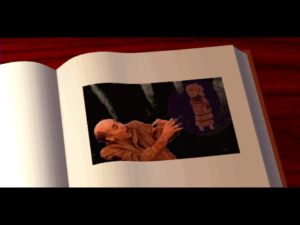
The backstory of how Stauf came to take up residence in his mansion is shown in the form of narrated storybook right after the opening credits.
The only thing missing from Costello’s script was any clear indication of what the player would be expected to do in the course of it all. Trilobyte planned to gate progress with “challenges to the player’s intellect and curiosity. Our list of things to avoid includes: impossible riddles, text parsers, inventories, character attribute points, sword fights, trolls, etc. All actions are accomplished via mouse only. Game rules will either be self-explanatory or simple enough to discover with minimal experimentation.” It sounded good in the abstract, but it certainly wasn’t very specific. Trilobyte wouldn’t seriously turn to the game part of their game for a long, long time to come.
The question of Guest‘s technical implementation was almost as unsettled, but much more pressing. Devine and Landeros first imagined showing digitized photographs of a real environment. Accordingly, they negotiated access to Jacksonville’s Nunan House, a palatial three-story, sixteen-room example of the Queen Anne style, built by a local mining magnate in 1892. But, while the house was fine, the technology just wouldn’t come together. Devine had his heart set on an immersive environment where you could see yourself actually moving through the house. Despite all his technical wizardry, he couldn’t figure out how to create such an effect from a collection of still photographs.
The Mansion

The Nunan House in Jacksonville, Oregon, whose exterior served as the model for the Stauf Mansion. The interior of the latter was, however, completely different, with the exception only of a prominent central staircase.
A breakthrough arrived when Devine and Landeros shared their woes with a former colleague from Virgin, an artist named Robert Stein. Stein had been playing for several months with 3D Studio, a new software package from a company known as Autodesk which let one build and render 3D scenes and animations. It was still an awkward tool in many ways, lagging behind similar packages for the Commodore Amiga and Apple Macintosh. Nonetheless, a sufficiently talented artist could do remarkable things with it, and it had the advantage of running on the MS-DOS computers on which Trilobyte was developing Guest. Devine and Landeros were convinced when Stein whipped up a spooky living room for them, complete with a ghostly chair that flew around of its own accord. Stein soon came to join them in Jacksonville, becoming the fourth and last inhabitant of their cozy little office.
3D Studio

The 7th Guest was the first major game to make extensive use of Autodesk’s 3D Studio, a tool that would soon become ubiquitous in the industry. Here we see the first stage of the modeling process: the Shaper, in which an object is created as a two-dimensional geometric drawing, stored in the form of points and vectors.

In the Lofter, an object’s two dimensions are extruded into three, as the X- and Y-coordinates of its points are joined to Z-coordinates.
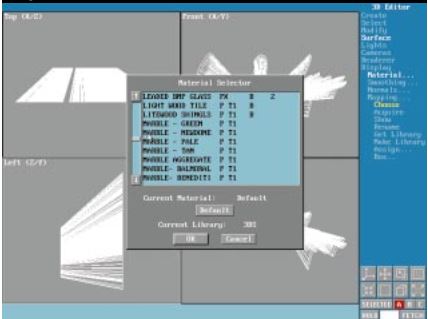
The 3D Editor is used to build a scene by hanging objects together in a virtual space and defining the position, color, and intensity of light sources.
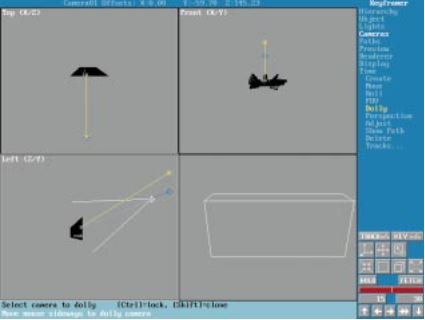
The Keyframer is used to create animation. The artist arranges the world in a set of these so-called key frames, then tells the computer to extrapolate all of the frames in between. The process was an extremely time-consuming one on early-1990s computer hardware; each frame of a complex animation could easily take half an hour to render.
Even using 3D Studio, Guest must fall well short of the ideal of an immersive free-scrolling environment. At the time, only a few studios — most notably Looking Glass Technologies and, to a much more limited extent, id Software of eventual Doom fame — were even experimenting with such things. The reality was that making interactive free-scrolling 3D work at all on the computer hardware of the era required drastic compromises in terms of quality — compromises which Trilobyte wasn’t willing to make. Instead they settled for a different sort of compromise, in the form of a node-based approach to movement. The player is able to stand only at certain pre-defined locations, or nodes, in the mansion. When she clicks to move to another node, a pre-rendered animation plays, showing her moving through the mansion.
Just streaming these snippets off CD fast enough to play as they should taxed Devine’s considerable programming talents to the utmost. He would later muse that he learned two principal things from the whole project: “First, CD-ROM is bloody slow. Second, CD-ROM is bloody slow.” When he could stretch his compression routines no further, he found other tricks to employ. For example, he got Landeros to agree to present the environment in a “letter-boxed” widescreen format. Doing so would give it a sense of cinematic grandeur, even as the black bars at the top and bottom of the monitor dramatically reduced the number of pixels Devine’s routines had to move around. A win win.
With the interior of the mansion slowly coming into being, the time was nigh to think about the ghostly video clips which would convey the story. Trilobyte recruited local community-theater thespians to play all the parts; with only $35,000 to spend on filming, including the camera equipment, they needed actors willing to work for almost nothing. The two-day shoot took place in a rented loft in Medford, Oregon, on a “stage” covered with green butcher paper. The starring role of Stauf went to Robert Hirschboeck, a fixture of the annual Oregon Shakespeare Festival, which was (and is) held in nearby Ashland. Diane Moses, Trilobyte’s faithful office manager, also got a part.
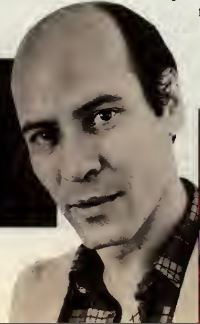
Robert Hirschboeck, the semi-professional Shakespearean actor who played the role of Stauf in The 7th Guest and its sequel. He was bemused by the brief fame the role won him: “I’ll be walking down the street and meet someone with all the CD-ROM gear, and they’ll say, ‘Ah, man, I’ve been looking at your ugly mug for 60 hours this week.'”
Trilobyte believed, with some justification, that their game’s premise would allow them to avoid some of the visual dissonance that normally resulted from overlaying filmed actors onto computer-generated backgrounds: their particular actors represented ghosts, which meant it was acceptable for them to seem not quite of the world around them. To enhance the impression, Trilobyte added flickering effects and blurry phosphorescent trails which followed the actors’ movements.
The Chroma-Key Process
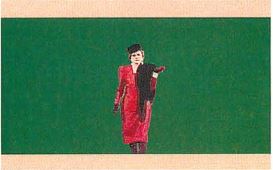
A technique known as chroma-keying was used by The 7th Guest and most other games of the full-motion-video era to blend filmed actors with computer-generated backgrounds. The actor is filmed in front of a uniform green background. After digitization, all pixels of this color are rendered transparent. (This means that green clothing is right out for the actors…)
While Trilobyte built their 3D mansion and filmed their actors, the project slipped further and further behind schedule. Already by May of 1991, they had to break the news to Alper that there was no possibility of a Christmas 1991 release; Christmas 1992 might be a more realistic target. Luckily, Alper believed in what they were doing. And the delay wasn’t all bad at that; it would give consumers more time to acquire the SVGA cards and CD-ROM drives they would need to run Guest — for by now it was painfully clear that a floppy-disk version of the game just wasn’t going to happen.
In January of 1992, Devine, Landeros, and Stein flew to Chicago for the Winter Consumer Electronics Show. They intended to keep a low profile; their plan was simply to check out the competition and to show their latest progress to Alper and his colleagues. But when he saw what they had, Alper broke out in goosebumps. Cinema connoisseur that he was, he compared it to Snow White and the Seven Dwarfs, Walt Disney’s first feature film, which forever changed the way people thought about cartoon animation. What Snow White had done for film, Alper said, Guest could do for games. He decided on the spot that it needed to be seen, right there and then. So, he found a computer on the show floor that was currently demonstrating a rather yawn-inducing computerized version of Scrabble and repurposed it to show off Guest. To make up for the fact that Trilobyte’s work had no music as of yet, he put on a CD of suitably portentous Danny Elfman soundtrack extracts to accompany it.
Thanks to this ad hoc demonstration, Guest turned into one of the most talked-about games of the show. Its stunning visuals were catnip to an industry craving killer apps that could nudge reluctant consumers onto the CD-ROM bandwagon. Bill Gates hung around the demo machine like a dog close to feeding time. Virgin’s competitor Origin Systems, of Wing Commander and Ultima fame, also sat up and took notice. They highlighted Guest as the game to watch in their internal newsletter:
Here’s a tip: keep an eye out for Guest, a made-for-CD-ROM title from Oregon developer Trilobyte for Virgin Games. In it, you explore a 22-room haunted mansion, complete with elaborate staircases, elegant dining rooms, a gloomy laboratory, and see-through ghosts. The version we saw is in a very primitive stage; there’s no real story line yet and many of the rooms are only rendered in black and white. But the flowing movement and brilliant detail in a few scenes which are fleshed-out are nothing less than spectacular. Ask anybody who saw it.
None of the press or public seemed to even notice that it was far from obvious what the player was supposed to do amidst all the graphical splendor, beyond the vague notion of “exploring.” The Trilobyte trio flew back to Oregon thoroughly gratified, surer than ever that all of their instincts had been right.
Still, with publicity came expectations, and also cynicism; Bill Gates’s enthusiasm notwithstanding, a group of multimedia experts at Microsoft said publicly that what Trilobyte was proposing to do was simply impossible. Some believed the entire CES demo had been a fake.
Trilobyte remained a tiny operation: there were still only Devine, Landeros, Stein, and Moses in their digs above the tavern. Other artists, as well as famed game-soundtrack composer George “The Fat Man” Sanger, worked remotely. But Devine, who had always been a lone-wolf coder, refused to delegate any of his duties now, even when they seemed about to kill him. “I’ve never seen someone work so hard on a project,” remembers one Virgin executive. The Fat Man says that “Graeme wanted to prove everyone else a liar. He knew he was going to be able to do it.” This refusal to delegate began to cause tension with Alper and others at Virgin, especially as it gradually became clear that Trilobyte was going to miss their second Christmas deadline as well. Virgin had now sunk twice the planned $300,000 into the project, and the price tag was still climbing. Incredibly, Trilobyte’s ambitions had managed to exceed the 650 MB of storage space on a single CD, a figure that had heretofore seemed inconceivably enormous to an industry accustomed to floppy disks storing barely 1 MB each; Guest was now to ship on two CDs. Devine and Landeros agreed to work without salary to appease their increasingly impatient handlers.
Only in these last months did an already exhausted Devine and Landeros turn their full attention to the puzzles that were to turn their multimedia extravaganza into a game. Trilobyte was guided here by a simple question: “What would Mom play?” They found to their disappointment that many of the set-piece puzzles and board and card games they wanted to include were still under copyright. Their cutting-edge game would have to be full of hoary puzzles plundered from Victorian-era texts.
But at least Trilobyte could now see the light at the end of the tunnel. In January of 1993, they made a triumphant return to CES, this time with far more pomp and circumstance, to unveil the game they were now calling The 7th Guest. Alper sprang for a haunted-house mock-up in the basement of the convention hall, to which only a handpicked group of VIPs were admitted for a “private screening.” Bill Gates was once again among those who attended; he emerged a committed 7th Guest evangelist, talking it up in the press every chance he got. And why not? It blew Sherlock Holmes Consulting Detective, the current poster child for CD-ROM gaming, right out of the water. Sherlock‘s herky-jerky video clips, playing at a resolution of just 160 X 100, paled next to The 7th Guest‘s 3D-rendered SVGA glory.
When it was finally released in April of 1993, the reaction to The 7th Guest exceeded Virgin and Trilobyte’s fondest hopes. Virgin began with a production run of 60,000, of which they would need to sell 40,000 copies to break even on a final development budget of a little over $700,000. They were all gone within days; Virgin scrambled to make more, but would struggle for months to keep up with demand. “Believe it or not, The 7th Guest really does live up to all the hype,” wrote Video Games and Computer Entertainment magazine. “It takes computer entertainment to the next level and sets new standards for graphics and sound.” What more could anyone want?
Well, in the long run anyway, a lot more. The 7th Guest would age more like raw salmon than fine wine. Already just two and a half years after its release to glowing reviews like the one just quoted, the multimedia trade magazine InterAction was offering a much more tepid assessment:
As a first-generation CD-ROM-based experience, The 7th Guest broke new ground. It also broke a lot of rules – of course, this was before anyone knew there were any rules. The music drowns out the dialog; the audio is not mixable. The video clips, once triggered, can’t be interrupted, which in a house of puzzles and constant searching leads to frustration. How many times can you watch a ghost float down a hallway before you get bored?
Everywhere The 7th Guest evinces the telltale signs of a game that no one ever bothered to play before its release — a game the playing of which was practically irrelevant to its real goals of demonstrating the audiovisual potential of the latest personal computers. Right from the moment you boot it up, when it subjects you to a cheesy several-seconds-long sound clip you can’t click past, it tries your patience. The Ouija Board used to save and restore your session seems clever for about half a minute; after that’s it’s simply excruciating. Ditto the stately animations that sweep you through the mansion like a dancing circus elephant on Quaaludes; the video clips that bring everything to a crashing halt for a minute or more at a time; the audio clips of Stauf taunting you which are constantly freezing the puzzles you’re trying to solve. The dominant impression the game leaves you with is one of slowness: the slowness of cold molasses coming out of the jar, of a glacier creeping over the land, of the universe winding down toward its heat death. I get fidgety just thinking about it.
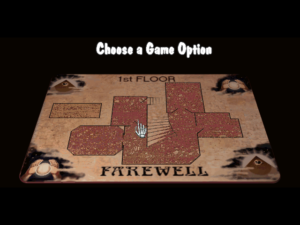
One of the game’s few concessions to player convenience is this in-game map. Yet it’s made so annoying to use that you hardly want to. First, you have to click through a menu screen which forces you to watch it tediously fading in and out, like every screen in the game. And then you have to watch the game fill in the map with colors square by exasperating square to indicate where you’ve solved the puzzles and where you still have puzzles remaining. This game would make an excellent trial of patience for a Zen school, if such institutions exist.
The puzzles that are scattered through the rooms of the mansion gate your progress, but not for any reason that is discernable within the environment. When you solve certain puzzles, the game simply starts letting you go places you couldn’t go before. In practice, this means that you’re constantly toing and froing through the mansion, looking for whatever arbitrary new place the game has now decided to let you into. And, as already noted, moving around takes forever.
The puzzles themselves were already tired in 1993. Landeros has been cheeky enough to compare The 7th Guest to The Fool’s Errand, Cliff Johnson’s classic Macintosh puzzler, but the former’s puzzles haven’t a trace of the latter’s depth, grace, wit, or originality. Playing The 7th Guest exposes a pair of creators who were, despite being unquestionably talented in other ways, peculiarly out of their depth when it came to the most basic elements of good game design.
For example, one of the puzzles, inevitably, is an extended maze, which the vast majority of players solve, assuming they do so at all, only through laborious trial and error. “The solution to the maze was on a rug in one of the bedrooms,” notes Devine. “We thought people would copy that down.” A more experienced design team would have grasped that good game design requires consistency: all of the other puzzles in the game are completely self-contained, a fact which has trained the player long before she encounters the maze not to look for clues like this one in the environment. Alternately, testers could have told the designers the same thing. The 7th Guest provides yet one more illustration of my maxim that the difference between a bad and a good one is the same as that between a game that wasn’t played before its release and one that was. “Our beta testing was, well, just us,” admits Devine.
Another infamous lowlight — easily the worst puzzle in the game in purely abstract design terms — is a shelf of lettered soup cans which you must rearrange to spell out a message. The problem is that the sentence you’re looking for makes sense only under a mustily archaic Scottish diction that vanishingly few players are likely to be familiar with.
But the worst puzzle in practical terms is actually Devine’s old abstract strategy game Spot, imported wholesale, albeit with the intelligence of your computer opponent cranked up to literally superhuman levels. It’s so difficult that even the official strategy guide throws up its hands, offering only the following clarification: “It is not necessary to beat this game to advance through The 7th Guest, and you will not be missing anything if you can’t beat it. To our knowledge, nobody has a consistent strategy to beat this game, not even Graeme!” The most serious problem here, even beyond the sheer lunacy of including a mini-game that even the programmer doesn’t know how to beat, is that the player doesn’t know that the puzzle is unnecessary. Thus she’s likely to waste hours or days on an insurmountable task, thinking all the while that it must gate access to a critical part of the plot, just like all the other puzzles. (What did I say about consistency?) Its presence is unforgivably cruel, especially in a game that advertised itself as being suitable for casual players.
None of the other puzzles are quite as bad as these, but they are samey — three of the 22 are chess puzzles, doubtless all drawn from the same Victorian book — at wild variance with one another in difficulty, and just generally dull, in addition to being implemented in ways calculated to maximize their tedium. Playing the game recently to prepare for this article, I never once felt that rush that accompanies the solution of a really clever puzzle. Working through these ones does indeed feel like work, made all the more taxing by the obstinately form-over-function interface. The best thing to be said about the puzzles is that they can all be bypassed by consulting an in-game hint book in the mansion’s library, albeit at the cost of missing the video clips that accompany their successful solutions and thus missing out on that part of the plot.
Still, one might want to argue that there is, paradoxical though it might sound, more to games than gameplay. Aesthetics have a value of their own, as does story; certainly The 7th Guest is far from the first adventure game with a story divorced from its puzzles. In all of these areas as well, however, it’s long since curdled. The graphics, no longer able to dazzle the jaded modern eye with their technical qualities, stand revealed as having nothing else to offer. There’s just nothing really striking in the game’s visual design — no compelling aesthetic vision. The script as well manages only to demonstrate that Matthew Costello is no David Lynch. It turns out that subversive surrealistic horror is harder to pull off than it looks.
As for the actors… I hesitate to heap too much scorn on them, given that they were innocent amateurs doing their best with a dodgy script in what had to feel like a thoroughly strange performing situation. Suffice to say, then, that the acting is about as good as that description would suggest. On the other hand, it does seem that they had some fun at least some of the time by hamming it up.
Indeed, the only claim to aesthetic or dramatic merit which The 7th Guest can still make is that of camp. Even Devine acknowledges today that the game is more silly than scary. He now admits that the story is “a bit goofy” and calls the game “Scooby Doo spooky” rather than drawing comparisons to The Shining and The Haunting, as he did back in the day. Which is progress, I suppose — but then, camp is such a lazy crutch, one that far too many games try to lean upon.
“The 7th Guest just kept selling and selling,” says its producer David Bishop of the months after its release. “We’d look at the sales charts and it had incredible legs. Sales were picking up, not slowing down.” By the end of 1996, the game would sell well over 2 million copies. Trilobyte was suddenly flush with cash; they earned $5 million in royalties in the first year alone. Nintendo gave them a cool $1 million upfront for the console rights; Paul Allen came along with another $5 million in investment capital. Trilobyte moved out of their little office above the tavern into a picturesque old schoolhouse, and started hiring the staff that had been so conspicuously missing while they made their first game. Then they moved out of the schoolhouse into a 29,000-square-foot monstrosity, formerly a major bank’s data center.
The story of Trilobyte after The 7th Guest becomes that of two merely smart men who started believing that they really were the infallible geniuses they were being hyped as. “Trilobyte thought they could pick up any project and it would turn to gold,” says one former Virgin staffer. “They had huge egos and wanted to grow,” says another. Even writer Matthew Costello says that he “could see the impact the attention from The 7th Guest had on [Devine and Landeros’s] perceptions of themselves.”
Despite the pair’s heaping level of confidence and ambition, or perhaps because of it, Trilobyte never came close to matching the success of The 7th Guest. The sequel, called The 11th Hour, shipped fully two and a half years later, but nonetheless proved to be just more of the same: more dull puzzles, more terrible acting, more technically impressive but aesthetically flaccid graphics. The zeitgeist instant for this sort of thing had already passed; after a brief flurry of early sales, The 11th Hour disappeared. Other projects came and went; Trilobyte spent $800,000 on Dog Eat Dog, a “workplace-politics simulator,” before cancelling it. Meanwhile Clandestiny, another expensive game in the mold of The 7th Guest, sold less than 20,000 copies to players who had now well and truly seen that the guest had no clothes.
Rob Landeros gradually revealed himself to be a frustrated filmmaker, always a dangerous thing to have around a game-development studio. Worse, he was determined to push Trilobyte into “edgy” content, rife with adult themes and nudity, which he lacked sufficient artistic nuance to bring to life in ways that didn’t feel crass and exploitative. When Devine proved understandably uncomfortable with his direction, the two fast friends began to feud.
The two founders were soon pulling in radically different directions, with Landeros still chasing the interactive-movie unicorn as if Doom had never happened, while Devine pushed for a move into real-time 3D games like the ones everyone else was making. New Media magazine memorably described Landeros’s Tender Loving Care as “a soft-porn film with a weak plot and rancid acting” after getting a sneak preview; the very name of Devine’s Extreme Warfare sounded like a caricature of bro-gamer culture. The former project was eventually taken by an embittered Landeros to a new company he founded just to publish it, whereupon it predictably flopped; the latter never got released at all. Trilobyte was officially wound up in January of 1999. “In the end, I never outran the shadow of The 7th Guest,” wrote Devine in a final email to his staff. “Mean old Stauf casts his long and bony shadow across this valley, and Trilobyte will always be remembered for those games and none other.”
In the aftermath, Devine continued his career in the games industry as an employee rather than an entrepreneur, working on popular blockbusters like Quake III, Doom 3, and Age of Empires III. (Good things, it seems, come to him in threes.) Landeros intermittently tried to get more of his quixotic interactive movies off the ground, whilst working as a graphic designer for the Web and other mediums. He’s become the keeper of the 7th Guest flame, for whatever that is still worth. In 2019, he launched a remastered 25th anniversary edition of the game, but it was greeted with lukewarm reviews and little enthusiasm from players. It seems that even nostalgia struggles to overcome the game’s manifest deficiencies.
The temptation to compare The 7th Guest to Myst, its more long-lived successor in the role of CD-ROM showcase for the masses, is all but irresistible. One might say that The 7th Guest really was all the things that Myst was so often accused of being: shallow, unfair, a tech demo masquerading as a game. Likewise, a comparison of the two games’ respective creators does Devine and Landeros no favors. The Miller brothers of Cyan Productions, the makers of Myst, took their fame and fortune with level-headed humility. Combined with their more serious attitude toward game design as a craft, this allowed them to weather the vicissitudes of fortune — albeit not without a few bumps along the way, to be sure! — and emerge with their signature franchise still intact. Devine and Landeros, alas, cannot make the same claim.
And yet I do want to be careful about using Myst as a cudgel with which to beat The 7th Guest. Unlike so many bad games, it wasn’t made for cynical reasons. On the contrary: all indications are that Devine and Landeros made it for all the right reasons, driven by a real, earnest passion to do something important, something groundbreaking. If the results largely serve today as an illustration of why static video clips strung together, whether they were created in a 3D modeler or filmed in front of live actors, are an unstable foundation on which to build a compelling game, the fact remains that we need examples of what doesn’t work as well as what does. And if the results look appallingly amateurish today on strictly aesthetic terms, they shouldn’t obscure the importance of The 7th Guest in the history of gaming. As gaming historians Magnus Anderson and Rebecca Levene put it, “The 7th Guest wasn’t anywhere near the league of professional film-making, but it moved games into the same sphere — a non-gamer could look at The 7th Guest and understand it, even if they were barely impressed.”
A year before Myst took the Wintel world by storm, The 7th Guest drove the first substantial wave of CD-ROM uptake, doing more than any other single product to turn 1993 into the long-awaited Year of CD-ROM. It’s been claimed that sales of CD-ROM drives jumped by 300 percent within weeks of its release. Indeed, The 7th Guest and CD-ROM in general became virtually synonymous for a time in the minds of consumers. And the game drove sales of SVGA cards to an equal degree; The 7th Guest was in fact the very first prominent game to demand more than everyday VGA graphics. Likewise, it undoubtedly prompted many a soul to take the plunge on a whole new 80486- or Pentium-based wundercomputer. And it also prompted the sale of countless CD-quality 16-bit sound cards. Thanks to The 7th Guest‘s immense success, game designers after 1993 had a far broader technological canvas on which to paint than they had before that year. And some of the things they painted there were beautiful and rich and immersive in all the ways that The 7th Guest tried to be, but couldn’t quite manage. While I heartily and unapologetically hate it as a game, I do love the new worlds of possibility it opened.
(Sources: the books La Saga des Jeux Vidéo by Daniel Ichbiah, Grand Thieves and Tomb Raiders: How British Video Games Conquered the World by Magnus Anderson and Rebecca Levene, and The 7th Guest: The Official Strategy Guide by Rusel DeMaria; Computer Gaming World of December 1990, May 1991, November 1992, October 1994, November 1994, June 1995, November 1998, December 1999, and July 2004; Electronic Entertainment of June 1994 and August 1995; Game Players PC Entertainment Vol. 5 No. 5; InterActivity of February 1996; Retro Gamer 85, 108, 122, and 123; Video Games and Computer Entertainment of August 1993; Zero of May 1992; Run 1986 Special Issue; Compute!’s Gazette of April 1985 and September 1986; ZX Computing of April 1986; Home Computing Weekly of July 19 1983; Popular Computing Weekly of May 26 1983; Crash of January 1985; Computer Gamer of December 1985 and February 1986; Origin Systems’s internal newslatter Point of Origin dated January 17 1992. Online sources include Geoff Keighly’s lengthy history of Trilobyte for GameSpot, John-Gabriel Adkins’s “Two Histories of Myst,” and “Jeremiah Nunan – An Irish Success Story” at the Jacksonville Review.
The 25th anniversary edition of The 7th Guest is available for purchase at GOG.com, as is the sequel The 11th Hour.)
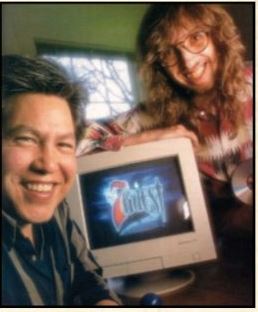

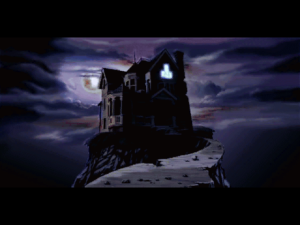

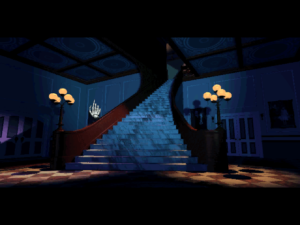
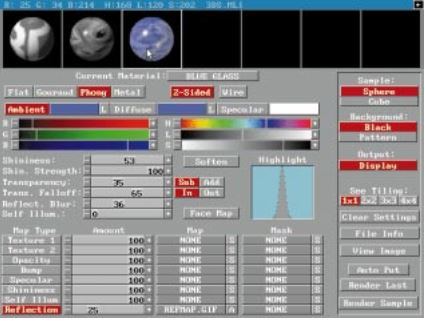
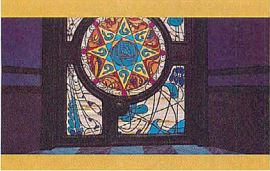
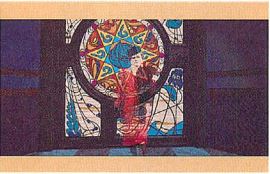
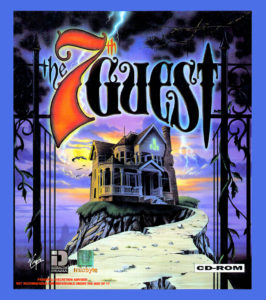
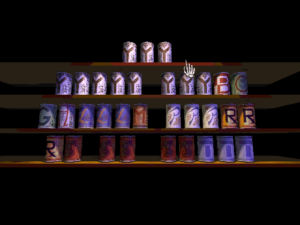











Jason B Dyer
April 3, 2020 at 6:03 pm
My favorite writing about Tender Loving Care is at Carl Muckenhoupt’s blog. It goes into lengthy detail.
https://www.wurb.com/stack/index.php?s=TLC&sbutt=Find
dsparil
April 3, 2020 at 7:14 pm
I never even realized that The 7th Guest was supposed to be scary! It is such a goofy game, and an awareness of that could have gone a long way. Not sure if you’re going to cover the Tex Murphy games at all, but they gained a lot from embracing some of the silliness innate to the premise.
You can really tell from playing it that the puzzles were a total afterthought. I am certainly not surprised that they were basically just tacked on at the end. I kinda feel like some of the blame can be pinned on Alpers not being a game player at all. It’s mind boggling that there wasn’t even a vague design from the outset and that it was greenlit at such a relatively high budget without one. Not that it ultimately mattered in this case, but the lack seemingly anyone with a solid sense of design is obviously what sunk the company in the end.
On Tender Loving Care, it’s definitely a trashy thriller. It actually starts out well enough, but devolves fairly quickly. Some of the endings are just nuts though. There’s actually barely any nudity in it, and it’s very likely to not see any of it in a play through . Calling it soft porn is such a huge exaggeration.
Jimmy Maher
April 3, 2020 at 7:21 pm
I suspect that the version of Tender Loving Care which was actually released was considerably toned-down from the one that was screened when it was still a Trilobyte project. There is precedent for this: The 11th Hour as well had quite some nudity as originally filmed, but cooler heads ultimately prevailed. The GameSpot history linked to in the comments has some… eye-opening descriptions of what was cut.
Alex Smith
April 4, 2020 at 12:37 am
“Nintendo gave them a cool $1 million simply to prevent them from selling the console rights to arch-rival Sega”
Actually, Nintendo was working on a CD-ROM expansion for the SNES first with Sony and then with Philips, famously causing the rift that led to the Sony PlayStation. I am pretty sure 7th Guest was signed for this add-on. Guest, as it was still called at the time, was featured in a two-page spread on the SNES CD drive in Nintendo Power in late 1992. The whole spread was aspirational rather than portraying actual SNES development work, but Guest was clearly something Nintendo hoped to release.
Jimmy Maher
April 4, 2020 at 7:04 am
That was the story as Trilobyte apparently understood it. Too bad, it was kind of a good one. :) Thanks!
Eric Nyman
April 4, 2020 at 2:02 am
Trilobyte’s Wikipedia page contains a few pieces of info that caused me to double take.
The company had twice as many unreleased games (10) than released games (5) in its history, including 4 failed attempts to extend the 7th Guest series–The 7th Guest III, The 13th Soul, The 7th Guest III 3rd Version, and the 7th Guest III: The Collector. For good measure, the last of those also failed to launch twice more in recent years via crowdsourced funding attempts.
However, there was a third “game” in the series, Uncle Henry’s Playhouse, which sold a grand total of 27 copies in the United States and 176 worldwide. I put “game” in quotation marks because 12 of the 13 puzzles were exact copies of those from the 7th Guest, 11th Hour and Clandestiny. But still, how can a game fail so spectacularly, especially considering the first two editions each sold well over a million copies each? Talk about having wrung every last drop out of a saturated market.
Also worth mentioning that another 7th Guest game was made by Attic Door Productions called The 13th Doll that just came out last year, and they even got Robert Hirschboeck to play Stauf again. http://www.the13thdoll.com/
Jimmy Maher
April 4, 2020 at 7:07 am
I can hardly express how *done* I am with The 7th Guest — but good to hear that Robert Hirschboeck is still around. He seemed like a good egg.
Peter Olausson
April 4, 2020 at 9:45 am
I’d like to see the incredibly low number of 176 copies sold double checked.
matt w
April 4, 2020 at 12:56 pm
Part 5 of the GameSpot article Jimmy links cites numbers from the firm PC Data, as does every other source I can find. The 27 copies sold thing is the number of copies sold in the 1996 holiday season. So I guess to check it, you might need to find old copies of PC Data’s numbers.
Joachim
April 4, 2020 at 9:02 am
A few years ago I got the silly idea that I would play every game in a collection of 75 games on one cassette (tape) for the Commodore 64. These were mostly written in BASIC, and obviously pretty small given that 75 of them were crammed onto one tape. Funnily enough, one of them was a less annoying version of a puzzle also featured in The 7th Guest. I actually doubt there are many puzzles in the game that one couldn’t recreate in BASIC for the Commodore 64.
The X
April 4, 2020 at 4:28 pm
Would a C64 have the horsepower to make the microscope puzzle as impossibly unfair as we all remember it being, though?
Joachim
April 5, 2020 at 12:21 am
Heh, I don’t know, but Spot was released for the C64, so… maybe? :)
Radiant
May 5, 2022 at 6:46 am
Sure, why not? It shouldn’t take more computing power than chess, and pretty much every low-ed system has a chess program too.
I know the puzzle from the old PC game Hexxagon, which is the same on a hex grid with decent (for its time) visual and sound effects.
matt w
April 4, 2020 at 1:26 pm
I was thinking that, with a modern sensibility of what works and what doesn’t and also with modern technology, it might be possible to make a Guest-like that isn’t terrible. Drop the silly puzzles and focus entirely on atmosphere, especially now that you can put in a lot more clips. And then… well, am I talking about Gone Home? Or modern FMV games like Her Story (and Telling Lies, I guess) and perhaps Bandersnatch?
On another note, the game Machinarium uses some of the same kind of silly puzzles–there are occasional locks opened by varieties of puzzles, some of which are relatively interesting and some of which are ancient chestnuts (there’s a four knights puzzle and a leapfrog puzzle, which is apparently also found in Trilobyte’s Clandestiny and then Uncle Henry’s Playhouse). I kind of enjoyed it there, partly because they weren’t the whole of the gameplay (there’s a fair amount of conventional point-and-clickery), and partly because the game is a show-off-our-art’em-up that’s really about showing off an interesting hand-drawn art style, rather than showing off technology that’s going to be painfully outdated within a few years.
Aula
April 5, 2020 at 8:46 am
“I was thinking that, with a modern sensibility of what works and what doesn’t and also with modern technology, it might be possible to make a Guest-like that isn’t terrible.”
Already done in 1996, called Bad Mojo. In both games you are confined to a single building, in which you move around and solve puzzles, for which you are rewarded with video clips that reveal the backstory.
matt w
April 5, 2020 at 8:07 pm
Interesting… I had been going to say “There was Bad Milk, of course” (“of course” meaning “I only just heard about it last year because of an entry into the annual Interactive Fiction competition, it’s apparently impossible to play now, and it has the reputation of being totally inexplicable and fairly awful yet it somehow won the Seumas McNally Grand Prize”). But this is a different Bad M.
One of my college classmates who developed an individualized major in videogames (in 1992) went on to work on a FMV game called Obsidian which I’ve always wondered about… that is, ever since I got into games and said “Hey, did Tom work on anything I’d have heard of?” Though maybe it’s more of a Mystlike than a Guest-’em-up. Also maybe most of the game isn’t FMV past the opening scenes, which are all I’ve seen on YouTube.
dsparil
April 6, 2020 at 3:46 pm
Obsidian is very much a Myst clone. If by FMV you mean “uses live actors” then it is limited to just the beginning and the end. However, using the literal definition there is quite a bit of FMV as movement between locations is fully animated in addition to general interaction. The game itself is decent, but a commercial failure with an ad campaign that is actually more memorable than the actual game.
Bad Milk isn’t really a game so much as an art installation that was deemed unworkable. I played it when it was released, and you’re not missing much but calling it awful is a bit unfair considering its roots.
If you take out the puzzles from something like The 7th Guest, you’re basically just left with a movie and then an interactive movie if choices are added to it. A “pure” Visual Novel that only has plot branches and no other gameplay is conceptually the same idea but with text. Then there’s also the fairly unique hybrid of Steins;Gate Elite which couples the text of the original VN with animation from the anime adaption plus some new animation for alternate and early “failure” endings that the anime obviously doesn’t include.
Lightly interactive games that are story heavy are a fairly well represented genre these days. There just aren’t many that use live actors, but even that has been increasing in recent years. Wales Interactive in particular has been filling that niche although they also publish/develop more “traditional” games too.
If you double down on the inexplicable puzzles of the The 7th Guest, you end up with the Professor Layton series which doesn’t even try to integrate the puzzles into the story except for one or two in every game except the first. People just ask them or they’re hidden in the environment. The difference being that the puzzles were created by the author of a decades long puzzle book series and lean towards more towards logic puzzles with significantly fewer mechanical ones. Also 150+ puzzles instead of two dozen.
CdrJameson
April 19, 2020 at 12:50 pm
There are plenty of live actors in games these days, but they (rather sensibly) tend to be motion and voice captured rather than appearing directly.
PEDRO FERREIRA
December 17, 2020 at 9:00 pm
Eeek! Gone Home. That game and Her story make The 7th Guest the cinematic equivalent of Citizen Kane.
Captain Kal
April 4, 2020 at 1:28 pm
Since I am not really into adventures (although I thoroughly enjoyed “The Dig”, and Legend Entertainment’s “Gateway II” ), the first jaw-dropping CD game was “Star Wars: Rebel Assault”.
Too bad it was exorbitantly expensive!! (And I owned an A1200 at the time, so playing an MS-Dos game, was out of the question!!).
Jacen aka Jaina
April 4, 2020 at 8:01 pm
considerable programming talents to the upmost”
Utmost? Though upmost might be a valid one as well.
Jimmy Maher
April 5, 2020 at 7:48 am
“Utmost” was the word I was looking for. Thanks!
John
April 4, 2020 at 8:43 pm
7th Guest really was very impressive for its time, visually speaking. I went to a friend’s house to watch him play and I was amazed by the graphics. I can also attest that the game’s atmosphere was, while not necessarily scary, at the very least unsettling. (It probably helped that 7th Guest was the first horror or quasi-horror game I’d ever seen.) Despite all that, the game didn’t appeal to me. Though I can no longer remember the details, I know I watched my friend work on at least two different puzzles and make zero progress on either. I’m afraid I was no help. As I recall, the game was unhelpfully unclear about not only what you were supposed to be doing but what it was you could do in the first place. I’m quite certain that any puzzles my friend ultimately ended up solving on his own he solved through pure trial and error and dumb luck.
Derek
April 4, 2020 at 9:30 pm
The disheveled young man in the parable is obviously id Software, or the first-person shooter genre in general, but who does the middle-aged woman represent?
After belatedly discovering Myst, my family ended up with a cheap collection of other games from that era, including The Journeyman Project, The 7th Guest, and Return to Zork. We finished The Journeyman Project, and I saw others in the family play a bit of The 7th Guest. We never went farther than the beginning of Return to Zork. Apparently, giving up on the latter two games was a wise decision on our part!
Jimmy Maher
April 5, 2020 at 7:56 am
She represents the new, non-traditional demographics that many publishers imagined CD-ROM games could reach by combining the qualities and approaches of film and television with interactivity. As the sales figures for The 7th Guest and Myst evince, a fair number of such folks were convinced to try such things out — but, as subsequent history evinces, very few of them were convinced by what they found to buy more such productions, much to the industry’s disappointment. Ironically, when the long-sought demographic expansion of gaming finally was achieved, it was via games that were the polar opposite of slow, cumbersome, heavily expository creations like The 7th Guest.
Moschops
April 6, 2020 at 9:53 am
” who does the middle-aged woman represent?”
While this archetype is clearly not her (not the right age, for starters), she’s certainly reminiscent of Roberta Williams playing Colossal Cave and deciding she could do better. Perhaps there’s a piece of Roberta Williams in this archetype.
Not Fenimore
April 5, 2020 at 4:57 am
Devine continued his career in the games industry as an employee rather than an entrepreneur, working on popular blockbusters like Quake III, Doom 3, and Age of Empires III
Good on him. I’m not much of an FPS guy, but (unpopular(?) opinion ahead) AOE3 is my favorite AOE. The shipments system is fun and adds a cute little deckbuilding element, and the units, for whatever reason, seem more distinctive and interesting than the ones in the other games.
Also, we’ve finally reached solve the soup cans!
Joshua Barrett
May 9, 2020 at 2:42 pm
Good for him indeed.
Speaking as an FPS fan, I can say that while Doom 3 is… certainly a game (not a particularly bad one, but none too great either), Quake III Arena is among the finest FPSes ever made.
…With the large asterisk being that it’s a more-or-less multiplayer-only experience, and a bit lacking in official content compared to its stablemate, Unreal Tournament. More than a few reviewers complained that it was just the same nine weapons as every other id game, with nothing new. However, as a deathmatch experience… it absolutely sings. It’s the platonic ideal of deathmatch, a minimalist gem polished until it absolutely shines (Carmack’s influence is writ large here), and to this day I’d argue that it has never really been beaten in its particular niche.
Torbjörn Andersson
April 5, 2020 at 7:54 am
I don’t know where else it was distributed, but I found a teaser – just a couple of very brief, silent movie clips – of Guest on the Magnetic Scrolls Collection CD of all things. The time stamps on the movie files are October 11 1990, but judging by the time stamps on other files the CD was released in 1992.
The movies show:
1. A Trilobyte Production logo.
2. A title screen. The house appears to be the same as in the final game, but much more brightly lit and on an different hill. It shows 1991 as the copyright year.
3. A door opening while the camera zooms in.
4. A headless ghost running through a corridor towards the camera.
There isn’t really any indication what the game is about. The demo menu just notes that “This early work has been compiled for demonstration purposes.”, and the README file says:
“Guest is a 3D animated Epic Fantasy game.
Guest has been developed for Virgin Games by Trilobyte using the latest 3D rendering and animation techniques.
(This Demo requires Super VGA)…”
Jimmy Maher
April 5, 2020 at 8:02 am
That’s interesting. I didn’t know that was there. The obvious common thread here is David Bishop, The 7th Guest’s producer at Virgin, who was very close to Magnetic Scrolls. He actually wrote Wonderland, their last text adventure.
Torbjörn Andersson
April 6, 2020 at 6:03 am
Do you need a copy of that teaser, or do you already have it? (Actually, it looks like Strand Games – who are in the process of remastering the Magnetic Scrolls games – have copies of the original games in their “brahman” GitLab project.)
Jimmy Maher
April 6, 2020 at 9:43 am
No, it looks like the CD version is, as you say, archived in that GitLab repository. Can always get it there. Thanks, though!
M. Casey
April 5, 2020 at 11:45 pm
Good work as always Mr. Maher.
I agree with Mrs. Fargo; at the time, Lexi-Cross was pretty good! Though I do remember getting it out of a deep discount bin at Electronics Boutique, so perhaps that wasn’t a good sign for its success.
BTW, wasn’t SVGA 800×600, not 640×480 as you mention above? Normal old VGA was 640×480 (albeit at sixteen colors).
Jimmy Maher
April 6, 2020 at 9:25 am
Yeah, my wife and I had a lot of fun with Lexi-Cross a while back. We played together because, while she’s much better than I am with puzzles in general, all of the obscure (and now mustily archaic) American trivia was too much for her. (I remember the first puzzle we got involved the Campbell and Wales Conferences of the old NHL.) I thought about writing about Lexi-Cross in more depth, but wasn’t sure I had that much that was interesting to say about it, other than that it strikes me as a game that could work really well on mobile with an updated implementation. Fun fact: Lexi-Cross started life as an X-rated version of Wheel of Fortune. It was, ironically enough, Rob Landeros of eventual Tender Loving Care fame who convinced Peter Oliphant that absolutely no publisher would dare to touch such a thing.
Vanilla VGA could do 640 X 480, but only in 16 colors. For this reason, it’s high-resolution mode, although widely used in business applications, was almost never used by games. SVGA was very amorphously defined in comparison to CGA, EGA, or VGA because it wasn’t based on a single IBM reference implementation which everyone else cloned. In practice, and despite some efforts to define specifications by the VESA board, it really just meant “anything better than VGA.” While some SVGA cards could indeed do 800 X 600 (and possibly better than that) by 1993, The 7th Guest runs in 640 X 480.
krebizfan
April 7, 2020 at 4:54 pm
The 16 color limit was not an impediment to games running on stock VGA. Many of the games written for the 320×256 mode only used 16 colors and ignored the remaining 240 colors of the possible palette. The problem for stock VGA was market share. For the first year of the PS/2 line-up, the MCGA models accounted for more than half of sales with a dominant position with the prime gaming playing audience of college students. Doing 640 x 480 assets would be a lot of work to go after probably around 10,000 high end PS/2s used for gaming.
SVGA may have allowed for higher resolutions but it was a long time before good quality monitors capable of exceeding 640×480 cost than than $1,000. Megabyte of RAM yielding 256 colors on a crisp 640×480 display was the way to go. Trying to make a game playable on a headache inducing monitor forced into 1024 x 768 mode would have been a considerable challenge.
Ross
April 8, 2020 at 3:49 am
I remember back in those days, when you put a monitor in a higher resolution, quite often it would make a sort of noise. Something that sent a message to your soul that the monitor was not happy with you about this.
Martin
April 8, 2020 at 11:20 pm
Ahh, the multi-sync monitor.
Steven Marsh
April 6, 2020 at 12:59 pm
Good article (as ever). I certainly respect your opinion, and I can easily see how they were formed. But 7th Guest occupies an odd place in my heart. I played dozens (if not hundreds) of games from this era, and it’s one of the only ones that I’ll fire up and tinker with for more than a few minutes.
The atmosphere always hit the sweet spot for me. I find the music to be top-notch. The “community theater” aesthetic scratches the right itch where there’s a delight in seeing what befalls them. The geography of the house “made sense” to me in a way that Myst never did. (“Wait; which rock face is this? If I turn right, am I — no, dang it, I’m back where I started.”) I liked how the rooms all felt different, and there was an anticipation with going into a new room after unlocking it.
Even many of the puzzles are enjoyable in their own way. It’s similar to how I take comfort in “solving” a 4×4 sliding-tile grid puzzle (even though it’s almost muscle memory by now); there’s still a tactile delight in seeing it come together.
And I enjoyed (enjoy) the plot. It actually “pays off” for me in a way that most games simply didn’t, and the less-than-linear nature of everything added to the disquieting atmosphere. And — unlike many adventure games that took pride on difficult or obtuse puzzles — 7th Guest “played fair,” in that it wasn’t possible to lock yourself out of victory, or to be missing a vital piece. And — again, unlike Myst for me — what you were expecting to do was very fair and up front, and the rewards for doing so were immediate and often . . . well, rewarding.
I admit that my original playing of this was enhanced by enjoying it in college, when I took scribbled notes of chess puzzles to my honors-dorm lobby and we muddled out answers. And the game exists in almost an ideal state in my head now, with just-enough half-remembered clues and details that I can enjoy it exactly as I want. (“Oh, right . . . ‘shy gypsy crypt’ something something . . .”)
Anyway, I’m not trying to dissuade you from your opinions; they’re perfectly rational, and I don’t begrudge anyone them. But 7th Guest still holds a place in my heart, where the promise of CD-ROM technology more-or-less paid off to what my imagination had hoped for.
DZ
July 13, 2020 at 9:13 pm
For what it’s worth, I agree with you. I like The 7th Guest. *shrug*
I actually got into PC games right around the time that the sequel came out, so I played the 11th Hour first. I remember enjoying it quite a lot, playing with a friend. We would play at night after work, in the dark, and I distinctly remember the spooky atmosphere that the music and videos provided.
We solved that game in a few nights, then, having heard that it was a sequel to the “critically acclaimed 7th Guest,” I went out and bought that one too.
My impression was that it was the same game, but “older,” as if it were a prototype of the eventual 11th Hour production. They had similar puzzles, but the ones in the 7th Guest seemed easier, and the atmosphere felt a bit more campy-horror than in the sequel.
I still enjoyed it immensely, perhaps even more so than the 11th Hour. I’ve actually played both a few times over the years.
Lastly, I’d like to add one thing that I think Jimmy’s chronicles seem to have missed, or attributed merely to design flaws.
I’ve played many games throughout the years, especially back in those heady days of “graphic adventure” and “FMV” games, and I distinctly remember seeing two types of games: those in which the puzzles were part of the story, typically involving story elements, characters, or inventory items. These were mostly the “classic” adventure games by Sierra and LucasArts. Even “FMV” games like Phantasmagoria follow the same ludic-puzzle pattern.
Then there were another type of game, very much like the 7th Guest and 11th Hour, in which the puzzles were pure logic cyphers — sometimes utilizing parts of the environment for effect, but mostly orthogonal to the plot itself. These were pure “plot gates” — nice brain teasing distractions that lead to unlocking more elements of the story.
You can say that such a design is bad, or a cop-out to actual immersive puzzle designs, and that may be your opinion. However, as I remember, it was a class of games on to themselves, following the tradition of adding mazes or “lever switching” puzzles and the like, all the way back to Zork and Colossal Adventure.
There certainly were fans of such games at the time, and magazine reviews offered opinions on the strength of the puzzles *and* of the story, as if they were two separate aspects of the game and its enjoyment.
It may not be your cup-o-tea (it is not mine, although I have enjoyed them on occasion), but to dismiss them all as just bad puzzles seems to me a bit narrow-minded.
To be sure, 7th Guest has many flaws in its design and execution. However, it was played to completion by a lot of people, and many still remember it fondly. I know I’ve played it much more than Myst — a game that I gave up on after just a few screens.
dZ.
Ross
July 15, 2020 at 9:47 pm
It’s strange. The whole trend of “standalone puzzles sprinkled through a largely unrelated game world as ways transparently to lock off progress” was, as I recall, widely credited with the demise of adventure games as a dominant genre (this is certainly unfair), and I know at the time I was among those who lamented the trend toward this style of game.
But it’s 2020 and “Sequence of set-piece puzzles connected by a plot told through cutscenes” is a pretty stable genre on mobile platforms now; it kinda ended up winning.
Lt. Nitpicker
April 7, 2020 at 3:04 pm
Worth noting that the Scrabble game shown off at the winter 92′ CES by Virgin was probably this one, for Windows.
https://www.mobygames.com/game/win3x/deluxe-scrabble-for-windows
Given it “supports” 256 color (640×480) SVGA (It will define a custom 16 color palette under such a mode for slightly better colors), and is published by Virgin, it’s probably the game mentioned. (Unlike the one linked in the article, which is published by U.S. Gold)
Jimmy Maher
April 7, 2020 at 3:16 pm
Thanks!
flowmotion
April 9, 2020 at 7:02 am
> “The 7th Guest just kept selling and selling,” says its producer David Bishop of the months after its release. “We’d look at the sales charts and it had incredible leg
There needs to be a huge boldfaced asterisks on these sales figures. Because all (US) brandname “Multimedia PCs,” and most CD-ROM upgrade kits includes 5-12 ‘free’ CD-ROMs. This collection of “shovelware” almost always included the The 7th Guest, even for years afterwards.
7th Guest was a good 5-10 minute demo on a 486 CD-ROM system. As *a game*. nobody ever cared. It wasn’t a “system seller”, it was a “system parasite”. It got bundled exactly because of the “highest low budget” shite.
I guess you could make a similar argument for Myst sales figures, but at least that was a geme some people liked playing alot.
Jimmy Maher
April 9, 2020 at 7:15 am
It’s long been standard practice not to count these sorts of throw-in deals as part of standard sales figures; otherwise, it would become trivially easy to game the system. And David Bishop has no reputation for dishonesty.
I’m almost certain the Myst sales figures include only boxed retail editions. I’m *slightly* less confident in the case of The 7th Guest, but still reasonably so. Certainly the anecdotal evidence supports the idea of 2 million plus sold at retail: its presence for months and months near the tops of sales charts, the buzz about it both inside and outside the traditional ghettos of computer gaming, the amount of money that poured into Trilobyte, the eagerness of venture capitalists and Nintendo to jump aboard (these people definitely do their homework), the surge in sales of CD-ROM drives and multimedia upgrade kits following its release (what was driving those sales if not The 7th Guest?), the number of people — even non-gamers — who still have memories of it today. If anything, I’m surprised that it *only* sold 2 million.
flowmotion
April 11, 2020 at 5:39 pm
Well, I worked at a business who purchased a CD-ROM kit in order to use an address database. And we got the 7th Guest and etc along with it. Hopefully you’re right and that sort of thing didn’t “count”.
Wouter Lammers
April 11, 2020 at 5:53 am
I’m not sure if our sale was counted for the numbers you mention here, but we played it on our brand new CD-i. I’m not sure if we ever finished it, all I really remember of it are chess puzzles, and the horrible remote control we had to use to play it. It was quite terrible but far from alone in the collection of crap we played on our soon to only good for gathering dust CD-i.
Spotted one “the Seventh Guest”, probably should be “the 7th Guest” everywhere.
Jimmy Maher
April 12, 2020 at 7:43 am
Thanks!
Iván Díaz Álvarez
April 11, 2020 at 4:37 pm
How did you know about Metropolis being uncompletable? Did you try to play it or did you found a source?
I have an original copy since it was reviewed in an Amstrad Magazine and piqued my interest, but it is really obscure and difficult to find anything online about it.
Jimmy Maher
April 12, 2020 at 7:52 am
Ah, therein lies a tale…
What must be fifteen or twenty years ago now, I downloaded Metropolis from the old Home of the Underdogs site and started playing it. I’m not sure why now, other than that I seem to recall Sarinee giving it quite a glowing write-up. Anyway, the version I downloaded crapped out on me about halfway through, which rankled. Assuming it was just a problem with the download, I eventually bought a copy on eBay and had it shipped all the way from Britain. (A. I could be very stubborn in those days. B. I was still living in the States.) I thought I could image the disks and upload a working version for posterity if all went well. But, much to my surprise, the game I’d bought crashed in the same place in the same way running off original disks on vintage hardware.
I’d forgotten all about this until I was researching this article, and saw Metropolis on Graeme Devine’s CV. I’d never made the connection before… Small world sometimes, isn’t it?
Iván Díaz Álvarez
April 12, 2020 at 1:33 pm
The home of the underdogs, how many hours checking it!. I like the fact that it still exists with a similar look (no downloads now, sadly).
I have several old PCs from 486 to Pentium III but nothing that can run Metropolis slow enough.
But I have the impression that was made for Amstrad machines that were the first popular PCs in Europe (and had some proprietary quirks), so perhaps I will someday try to run it in PCem that can specifically emulate an Amstrad pc1512 to see if it still has that problem.
Jimmy Maher
April 13, 2020 at 7:26 am
Cool. Let me know if you learn anything!
Wolfeye M.
April 18, 2020 at 8:00 am
Hrm… reminds me of the kind of movies they’d have on MST3K or B movies in general. Sometimes I can tell the filmmakers were ambitious, put their heart into it, and wanted to make the best movie they could. But…all they could afford was a “ray gun” made of cardboard covered with aluminum foil, or an obviously toy submersible, or something like that. For whatever reason, the final product doesn’t quite measure up to what they wanted to do.
The Confabulist
June 9, 2020 at 5:20 pm
Regarding the potential entertainment value of FMV, I wonder what your feelings are on the recent “Her Story” and “Telling Lies”?
Jimmy Maher
June 9, 2020 at 7:22 pm
Haven’t played Telling Lies yet, but thought Her Story was quite brilliant. In certain applications that take account of its limitations, full-motion video can work really well.
PEDRO FERREIRA
December 17, 2020 at 9:05 pm
Quite brilliant? It makes the acting and interactivity in This game look like Citizen Kane!
PEDRO FERREIRA
December 17, 2020 at 9:09 pm
The 7th Guest was brilliant for the time although it had flaws one of which was having a specific reason to complete the puzzles. The hammy acting and terrific music added to the atmosphere. There’s a good reason the series has fans years later. That’s the mark of a long-lasting game series.
Is the game worthless? No way!
Fronzel
February 21, 2021 at 6:03 am
I’m left wondering why Landeros didn’t simply try to make films instead of games-as-films.
Rob
February 19, 2023 at 3:33 am
Excellent write up, but I do think the disdain for the game isn’t entirely fair. It was made at a time where nothing else like it existed, and I thought they built a highly atmospheric game worth playing through at the time even if a large % of the puzzles needed help to get past. It absolutely is full of flaws but its from these efforts that we learned what doesn’t work as much as what does. I’d argue at the least the game contributed significantly to proving atmosphere and “tone/feel” of the game matters.
Again, great write up but I think I detect a little personal bias in the review rather than an objective analysis of the historical place of this game.
PEDRO FERREIRA
July 15, 2024 at 1:07 pm
I have to agree here. It is off-putting to read.
Hresna
August 11, 2024 at 10:43 am
I will offer a minor editorial note, albeit a completely unnecessary one, and only as a pretence to share an anecdote.
I had never played 7th Guest, but I played a demo version of 11th Hour that had come on the pack-in CD with a game magazine. The demo included a single chess puzzle in a central room, involving only knight pieces, which (magically?) unlocked all the doors in that area. I couldn’t quite wrap my head around how the puzzle was meant to link to the story in any way.
Some time later, I remember being rather amused when reading the “awards” this particular magazine had dolled out for the year to various titles. To this game, it conferred the award “The ‘what game is this a sequel to’ award”, because it’s official title was in fact “The 11th Hour: The Sequel to the 7th Guest”. It amused me enough that I remember it to this day.
As a side note, this style of “explore and solve pure logic puzzles” seemed to have enjoy a brief resurgence in the relatively popular indie game The Witness.
Jimmy Maher
August 12, 2024 at 7:33 am
I suspect that comparison is a bit unfair to The Witness; although I haven’t played it, it’s my understanding that its puzzles are the entire point of its existence. The points of The 7th Guest, on the other hand, are the pre-rendered 3D environments and the digitized video clips. The puzzles came in only when the designers looked at one another at the last minute and said, “Oh! We have to give the player something to actually do if we’re going to sell this thing as a computer game!”
On another note, there does seem to have been a feeling for a while that Roman numerals for sequels were a bit too lowbrow for some games with highbrow aspirations. Riven, for example, also billed itself rather tortuously as “Riven: The Sequel to Myst.”
Ross
August 13, 2024 at 3:13 pm
I might theorize that independent of the trend of viewing numbered sequels as lowbrow, it feels linguistically clumsy to add an ordinary (This is the second time in my life I’ve used that word to mean this thing) number to a title that already has a number in it. “The 7th Guest II: The 11th Hour” starts to border on sounding like a Mad Magazine joke about confusing sequel names.